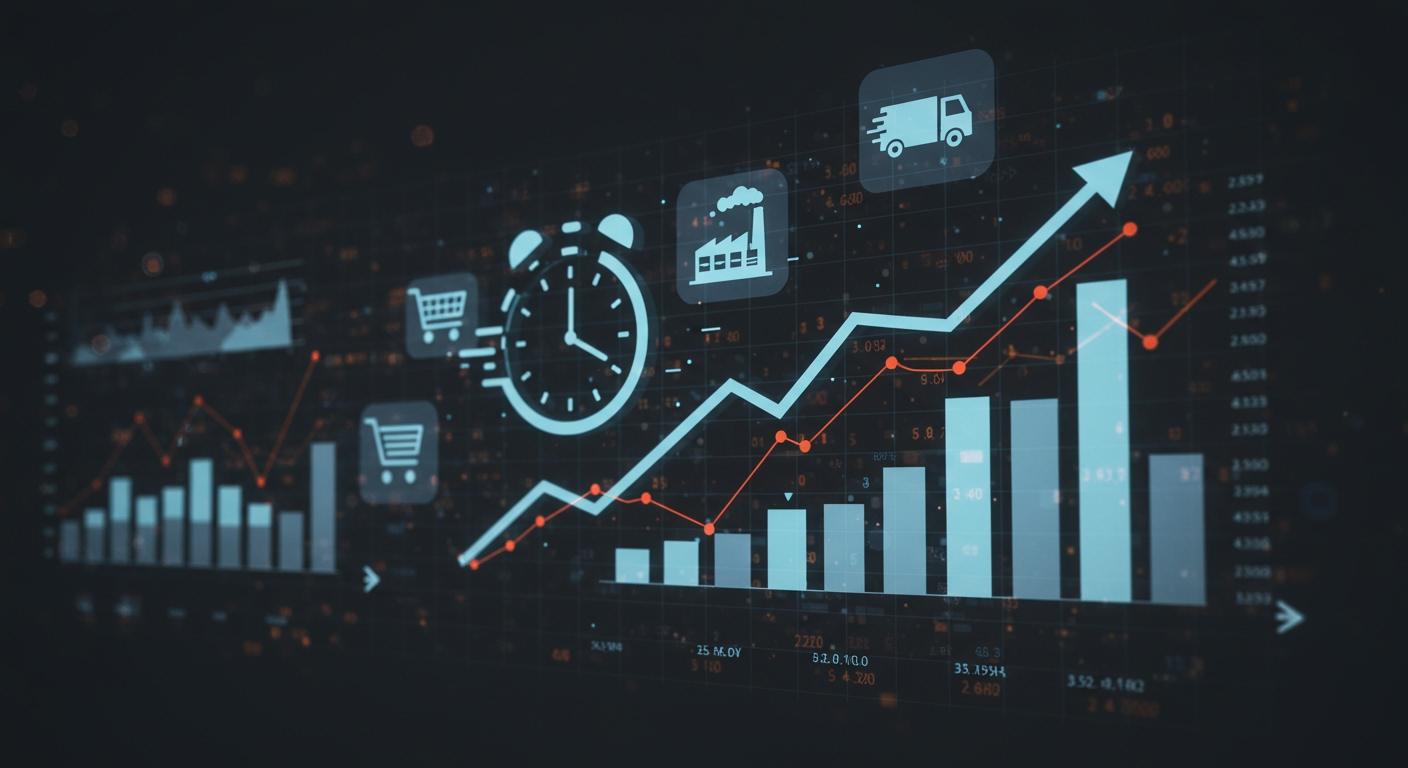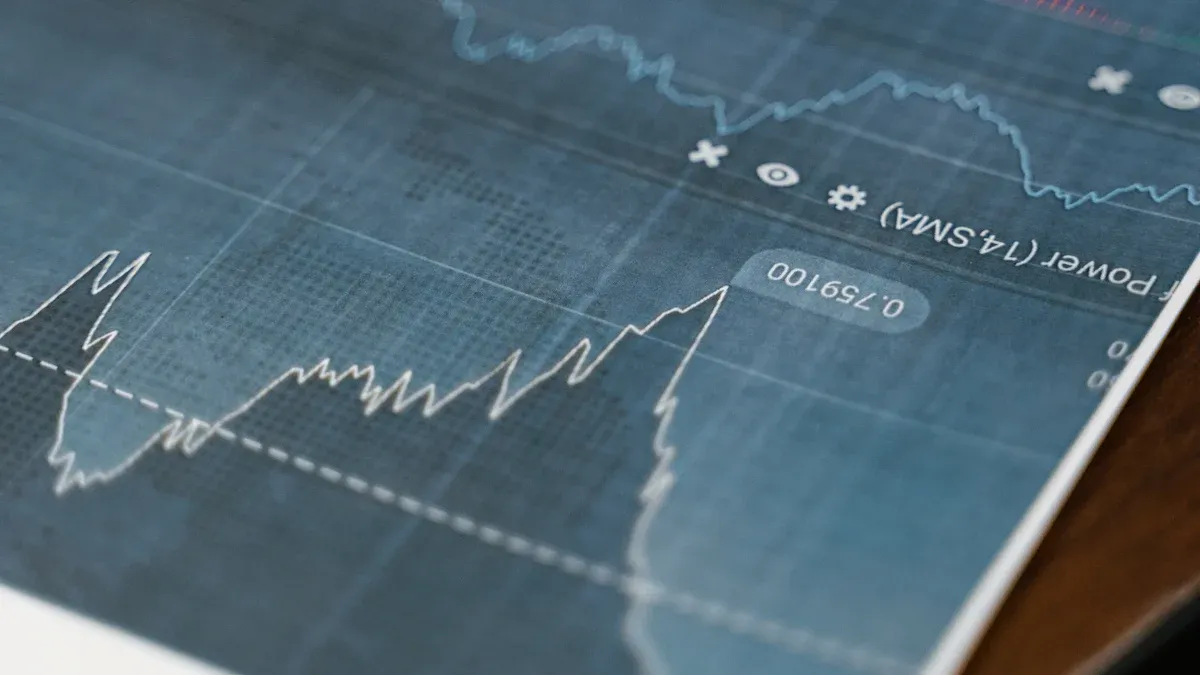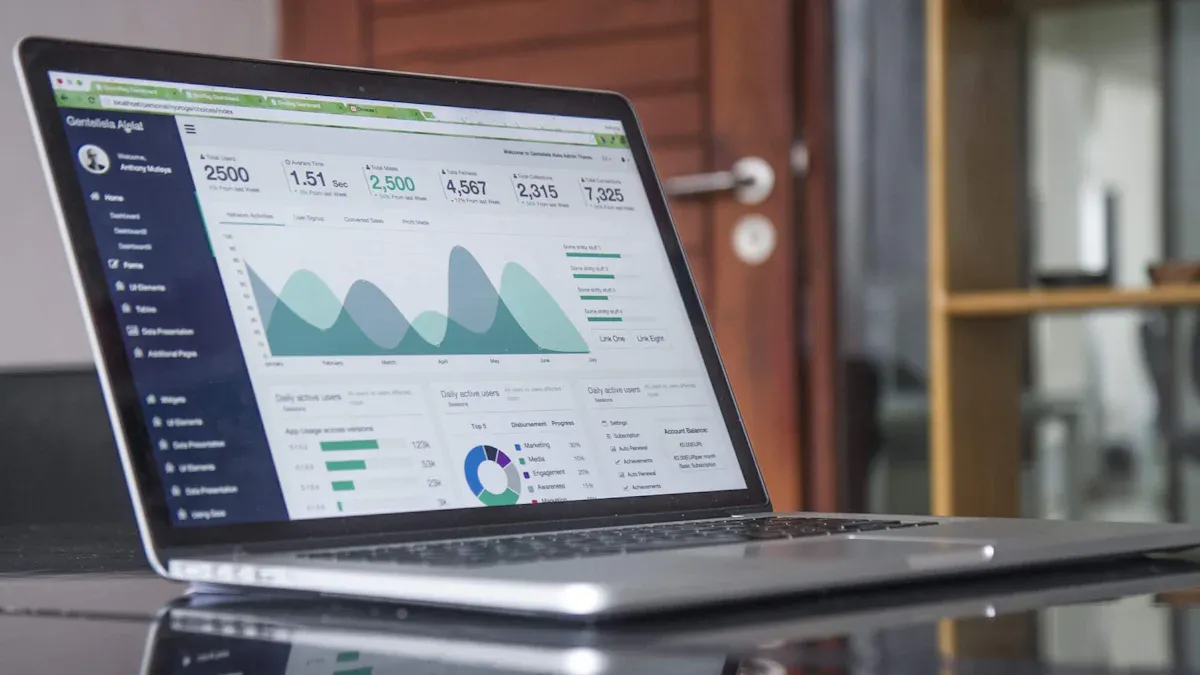
Your ecommerce business faces high stakes with limited-time offers. You risk frustrating stockouts and lost sales. You also face profit-draining overstock. Mastering real-time demand forecasting is the essential strategy to navigate these events. This approach to demand forecasting helps you prepare for high-demand sales.
Successful ecommerce demand forecasting turns real-time data into accurate demand forecasting. This process directly lowers your stockouts and overstock rates.
These powerful forecasting strategies help you manage demand. You can prevent stockouts and maximize the potential of every launch.
Use Machine Learning for Predictive Analytics

You can elevate your demand forecasting from a simple historical review to a predictive science. Machine learning (ML) gives your ecommerce business a powerful advantage. It analyzes complex data to create a highly accurate forecast. This strategy helps you anticipate customer demand with incredible precision, reducing both stockouts and costly overstock.
How ML Identifies Patterns
AI and ML algorithms identify crucial patterns that humans might miss. They process massive datasets from both internal and external sources to improve forecast accuracy. Your internal data includes historical sales, website traffic, and customer behavior. The system then combines this with external signals for a complete picture of demand.
Tip: Smart demand forecasting looks beyond your own data. ML models can incorporate external factors to understand market-wide shifts that impact your sales.
Key external datasets for accurate demand forecasting include:
- Economic Indicators: Factors like consumer confidence, inflation rates, and GDP growth influence customer spending habits.
- Weather Patterns: Weather data is vital for forecasting demand for products affected by seasonality.
- Competitor Actions: Your competitors' pricing and promotions directly affect your own sales performance.
Analyzing these variables together helps you understand seasonality and event-based trends for better demand prediction. This is one of the most effective demand forecasting techniques for modern commerce.
Modeling Your Flash Sale Curve
Machine learning excels at modeling the unique demand curve of a flash sale. You can use ML to predict how promotions, timing, and pricing will impact sales velocity. Recent research shows ML is also effective for multi-product price optimization during a sale, helping you maximize profit across your catalog.
This level of forecasting accuracy is already delivering results in the commerce world. For instance, one electronics wholesaler improved its five-month forecast accuracy by 15% by using ML. This led to an 85% accuracy rate in predicting new product performance. This advanced forecasting helps you prepare the right amount of inventory, preventing stockouts while protecting your margins.
Centralize Data for Real-Time Demand Forecasting

Your machine learning models need high-quality fuel to run. That fuel is your data. Disconnected data from sales, marketing, and inventory creates an incomplete picture of demand. This leads to poor forecasting, stockouts, and lost revenue. You can achieve accurate demand forecasting by unifying all your data into a single, accessible location. This strategy is the foundation for effective real-time demand forecasting.
Creating a Centralized Data Hub
You need a central hub to manage your information effectively. A Customer Data Platform (CDP) is an excellent tool for this job. It collects and organizes customer data from all your ecommerce touchpoints. This gives you a complete view of customer behavior, which is vital for smart demand forecasting and understanding seasonality. Your team gets a single source of truth for all forecasting activities.
Note: CDPs are designed for modern commerce. They help data analysts and scientists manage, transform, and analyze information for better performance.
Popular platforms that help ecommerce businesses achieve this include:
- Twilio Segment
- mParticle
- Adobe Real-Time CDP
- Treasure Data
Using a CDP improves your forecast accuracy and prepares you for shifts in demand.
Gaining an Up-to-the-Minute View
A data hub is only useful if the information is current. You need an up-to-the-minute view of your business performance. Automated inventory management systems are essential for this. They sync sales data across all your channels the moment a transaction happens. This process prevents overselling and stockouts.
You can use cloud integration tools and AI-powered automation to connect your systems. These technologies eliminate data silos and enable real-time data sharing. This level of accuracy in your data ensures your forecast reflects true market demand. Better data leads to better forecasting, helping you avoid overstock and maximize sales. This approach to demand forecasting turns your data into a powerful asset for your commerce operations.
Key Ecommerce Demand Forecasting Strategies
Your forecasting should not stop at your website's edge. Conversations happening on social media offer a goldmine of data for your ecommerce business. You can tap into public sentiment and online buzz to create a more dynamic demand forecasting model. This approach helps you understand customer demand before it ever hits your store.
Using Social Listening and Sentiment
You can monitor social media platforms for mentions of your brand, products, and competitors. This is social listening. It gives you a real-time pulse on customer perception and intent. Sentiment analysis tools then categorize these mentions as positive, negative, or neutral. This process is crucial for accurate ecommerce demand forecasting. It helps you understand how customers feel about your products, which directly impacts demand and seasonality.
Tools that can help you with this forecasting process include:
- Sprout Social: Uses AI to detect trend anomalies and summarize conversations.
- Brand24: Provides instant alerts and visualizes sentiment trends.
- YouScan: Analyzes sentiment for specific product features.
Using these tools transforms raw social data into actionable insights for your commerce operations.
Analyzing Social Buzz as a Signal
The volume of conversation, or "buzz," is a powerful predictor of future sales. Research confirms that pre-launch online buzz on forums and social media directly relates to first-day sales figures. This makes social buzz a key signal for your ecommerce forecasting. You can measure this demand to adjust your inventory and marketing strategy before a launch.
An emerging streetwear brand provides a great example. The company used Instagram saves and story poll data to gauge demand for a new jacket. High engagement and specific color preferences from polls informed their inventory order. This proactive forecasting led to the jacket selling out weeks ahead of schedule, doubling projected revenue.
This strategy turns public interest into a reliable forecasting metric. It helps you prepare for demand spikes and understand product-specific seasonality. By integrating these external signals, your demand forecasting becomes significantly more accurate and responsive.
| Feature | Traditional Forecasting | AI-Powered Forecasting |
|---|---|---|
| Accuracy | 60-75% | 85-95%+ |
| Adaptability | Less adaptable to sudden market changes | Highly adaptable to market shifts and trends |
| Data Sources | Primarily historical sales data | Historical sales, social media trends, real-time behavioral data |
This modern approach to ecommerce demand forecasting helps you move beyond simple historical sales data. You gain a competitive edge in a fast-moving commerce landscape.
Website Analytics for Demand Forecasting
Your ecommerce website is a powerful source of real-time data. The actions shoppers take provide direct clues about future demand. By analyzing this on-site behavior, you can move beyond historical sales data. This approach to demand forecasting gives you a live view of customer intent, which is essential for improving your forecast accuracy and sales performance.
Tracking Real-Time Shopper Actions
You can track specific shopper actions to understand purchase intent. This goes far beyond just monitoring "add-to-cart" events. Your ecommerce platform captures valuable signals that indicate strong interest in your products. This data is a goldmine for accurate demand forecasting.
Strong signals of purchase intent for your ecommerce business include:
- Repeated visits to specific product pages.
- Longer time spent browsing during a single session.
- Frequent exploration of related product categories.
You can use web analytics platforms to monitor this activity. These tools offer real-time reporting to give you immediate insights into your commerce performance.
- Mixpanel: Use this for advanced event tracking to capture specific user actions.
- Google Analytics: This is ideal for website and conversion tracking, especially with Google Tag Manager for custom click events.
- Chartbeat: This platform analyzes customer behavior and content interaction, offering a live view of visitor activity.
Turning Intent into Forecasts
These digital footprints are the inputs for your ecommerce demand forecasting. You can turn shopper intent directly into a quantifiable forecast. This process transforms raw clicks into a reliable measure of potential demand, making your forecasting more precise.
Clicks on a "notify me when available" button are a direct measure of demand. If 500 people request a notification for an out-of-stock item, you have a clear baseline for your next inventory order. This simple metric is a powerful tool for ecommerce forecasting.
This method enhances the accuracy of your forecasting models. By quantifying interest before a product is even available, you create a more reliable demand forecast. This strategy helps you optimize inventory, drive sales, and make your commerce operations more efficient. This level of demand forecasting ensures you are prepared for every sales opportunity.
Pre-Launch A/B Testing for Ecommerce
You can improve your forecasting before a product even goes live. Pre-launch A/B testing lets you measure audience interest with real data. This strategy for ecommerce demand forecasting turns marketing tests into a powerful tool for predicting sales performance. You test different marketing messages to see which one creates the most demand. This forecasting method gives your ecommerce business a significant advantage.
Gauging Audience Response
You can gauge audience response by testing variations of your launch marketing. This process helps you understand potential demand. Create two or more versions of an ad, email, or landing page. Each version should have a different headline, image, or call to action. You then show these variations to small segments of your target audience.
Pro Tip: Use a clear call to action like "Sign up for launch updates" or "Get notified." The number of sign-ups is a direct signal of purchase intent and future demand.
Your goal is to measure engagement. Key metrics for this forecasting approach include:
- Click-through rates (CTR) on ads.
- Conversion rates on email sign-up forms.
- Engagement levels on social media posts.
This data shows which marketing approach drives the most interest. This information is vital for accurate forecasting and predicting sales.
Using Test Data to Refine Forecasts
You use the data from your tests to refine your forecast. This step turns audience interest into a number you can use for inventory planning. The performance of your test campaigns helps you build a more reliable ecommerce forecasting model. This improves your overall forecast accuracy.
For example, imagine your test ad generates 1,000 email sign-ups for a product launch. Your historical data shows that 10% of launch-notification subscribers make a purchase. You can now create a baseline forecast for 100 initial sales. This data-driven forecasting provides a solid foundation for your inventory decisions. This level of accuracy helps your commerce operations prepare for the real demand. This approach to ecommerce demand forecasting reduces risk and maximizes your sales potential. Better accuracy in your forecast means better business performance for your ecommerce brand. This is a key strategy for modern commerce.
You have five powerful strategies for real-time demand forecasting. These demand forecasting strategies transform your forecasting from a guess into a data-driven science, improving your forecast accuracy.
Do not feel overwhelmed. Start with one strategy. This step improves your ecommerce demand forecasting for the next sales.
Your goal is better forecasting to meet demand and maximize sales. This forecasting accuracy prevents stockouts and overstock. A strong forecast prepares your commerce for any demand. This real-time demand forecasting is key for your ecommerce business. Better demand forecasting prevents stockouts. This improves your forecast accuracy. This forecasting helps you understand demand. Your forecast will guide your sales.
FAQ
### What is real-time demand forecasting?
Real-time demand forecasting uses live data to predict customer demand. You analyze current sales, website traffic, and social media trends. This approach gives you an up-to-the-minute view. It helps you react quickly to market changes and improve your forecast accuracy for better commerce performance.
### Which forecasting strategy should I start with?
You can start with a simple, high-impact strategy. Analyzing your website analytics or using social listening are excellent starting points. These methods provide valuable demand signals without requiring complex setups. They offer immediate insights to improve your ecommerce forecasting for the next sales event.
### How much data do I need for machine learning?
Machine learning models perform best with large, high-quality datasets. However, you can start with the historical data you already have.
Key Insight: The quality of your data is more important than the quantity. Start by centralizing your existing sales and customer data to build a strong foundation.
### Can these strategies forecast demand for new products?
Yes, they are ideal for new product launches. You can use pre-launch A/B testing and social listening to measure interest before the product is available. These strategies turn audience engagement into a quantifiable forecast, reducing the uncertainty of launching something new.
See Also
Predicting Consumer Shopping Habits with AI-Powered Demand Forecasting
Optimizing Retail Inventory: Predictive Analytics for Future Re-stocking Strategies
Boosting Production Forecast Accuracy: AI Best Practices for Enterprises in 2024
Modernizing Retail Replenishment: Streamlined Strategies and Best Practices for 2024
Crafting Optimal Merchandise Assortments: Innovative Retail Planning for 2024